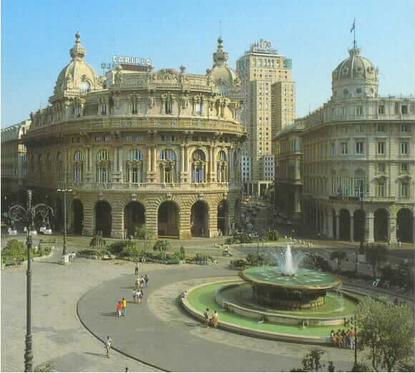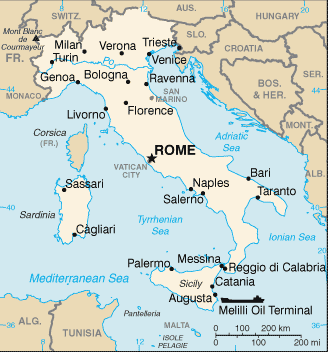|
Genova, Italy.

The conference will be held at the University, in the XVI
century Villa Cambiaso.
Address:
Via Montallegro, 1
Villa Cambiaso
16145 Genova GE
Conference rooms:
October 17 and 18 :
Room Salone di Rappresentanza (Plenary Room)
Room A8
Room A9
Room A3
October 19:
Room A5
Room A6
Conference Site:
http://www.ingegneria.unige.it/albaro.asp
The
following text and the links is received by
www.wikipedia.com
Ancient era and early Middle
Ages

Genoa's history goes back to ancient times. The first
historically known inhabitants of the area are the
Ligures,
an Italic tribe. The attribution of its foundation to
Celts in
2500–2000 BC has been recently recognized as wrong.[citation
needed]
A city cemetery, dating from the 6th and 5th centuries BC,
testifies to the occupation of the site by the
Greeks, but
the fine harbor probably was in use much earlier, perhaps by the
Etruscans. It is also probable that the
Phoenicians had bases in Genoa, or in the nearby area, since an
inscription with an alphabet similar to that used in
Tyre has been found[citation
needed].
In the
Roman era, Genoa was overshadowed by the powerful
Marseille
and
Vada Sabatia, near modern
Savona.
Different from other Ligures and Celt settlements of the area, it was allied
to Rome through a foedus aequum ("Equal pact") in the course of the
Second Punic War. It was therefore destroyed by the
Carthaginians in 209 BC. The town was rebuilt and, after the end of the
Carthaginian Wars, received municipal rights. The original castrum
thenceforth expanded towards the current areas of Santa Maria di Castello
and the San Lorenzo promontory. Genoese trades included skins, wood, and
honey. Goods were shipped in the mainland up to important cities like
Tortona
and
Piacenza.
After the fall of the
Western Roman Empire, Genoa was occupied by the
Ostrogoths. After the
Gothic War, the Byzantines made it the seat of their vicar. When the
Lombards
invaded Italy in 568, the Bishop of Milan fled and held his seat in Genoa.[2]
Pope Gregory the Great was closely connected to these bishops in exile, for
example involving himself the election of Deusdedit.[3]
The Lombards, under King Rothari, finally captured Genoa and other Ligurian
cities in about 643.[4]
In 773 the Lombard Kingdom was annexed by the
Frank
empire; the first Carolingian count of Genoa was Ademarus, who was given the
title praefectus civitatis Genuensis. Ademarus died in Corsica while
fighting against the Saracens. In this period the Roman walls, destroyed by
the Lombards, were rebuilt and extended.
For the following several centuries, Genoa was little more
than a small, obscure fishing center, slowly building its merchant fleet
which was to become the leading commercial carrier of the Mediterranean Sea.
The town was sacked and burned in 934 by Arab pirates but it was quickly
rebuilt.
In the 10th century the city, now part of the Marca
Januensis ("Genoese Mark") was under the Obertenghi family, whose first
member was Obertus I. Genoa was one of the first cities in Italy to have
some citizenship rights granted by local feudataries.
Middle Ages and Renaissance
Before 1100, Genoa emerged as an independent
city-state, one of a number of
Italian city-states during this period. Normally, the
Holy Roman Emperor was overlord and the
Bishop of Genoa was president of the city; however, actual power was
wielded by a number of "consuls" annually elected by popular assembly. Genoa
was one of the so-called "Maritime Republics" (Repubbliche
Marinare), along with
Venice,
Pisa, and
Amalfi) and
trade, shipbuilding and banking helped support one of the largest and most
powerful navies in the
Mediterranean. The
Adorno,
Campofregoso, and other smaller merchant families all fought for power
in this
Republic, as the power of the consuls allowed each family faction to
gain wealth and power in the city. The
Republic of Genoa extended over modern
Liguria
and
Piedmont, Sardinia, Corsica and had practically complete control of the
Tyrrhenian Sea. Through Genoese participation on the
Crusades,
colonies were established in the
Middle East, in the
Aegean,
in Sicily
and Northern
Africa. Genoese Crusaders brought home a green glass goblet from the
Levant,
which Genoese long regarded as the
Holy
Grail.
The collapse of the
Crusader States was offset by Genoa’s alliance with the
Byzantine Empire, which opened opportunities of expansion into the
Black Sea
and Crimea.
Internal feuds between the powerful families, the
Grimaldi
and
Fieschi, the
Doria,
Spinola, and others caused much disruption, but in general the republic
was run much as a business affair. In 1218–1220 Genoa was served by the
Guelph
podestà
Rambertino Buvalelli, who probably introduced
Occitan literature to the city, which was soon to boast such
troubadours as
Jacme
Grils,
Lanfranc Cigala, and
Bonifaci Calvo. Genoa's political zenith came with its victory over the
Duchy of Pisa
at the naval
Battle of Meloria (1284), and its persistent rival, Venice, in 1298.
However, this prosperity did not last. The
Black
Death was imported into Europe in 1349 from the Genoese trading post at
Caffa (Theodosia)
in Crimea, on the Black Sea. Following the economic and population collapse,
Genoa adopted the Venetian model of government, and was presided over by a
doge (see
Doge of Genoa). The wars with Venice continued, and the
War of Chioggia (1378–1381), ended with a victory for Venice. In 1390
Genoa initiated a crusade against the Barbary pirates with help of the
French and laid
siege to Mahdia. After a period of French domination from 1394–1409,
Genoa came under rule by the
Visconti of
Milan. Genoa lost Sardinia to
Aragon,
Corsica to internal revolt and its Middle Eastern colonies to the
Ottoman Empire and the Arabs.
Christopher Columbus, a native of
Genoa, donated one-tenth of his income from the discovery of the
Americas
for Spain to
the
Bank of San Giorgio in Genoa for the relief of taxation on foods. The
Spanish connection was reinforced by
Andrea Doria, who established a new constitution in 1528, making Genoa a
satellite of the Spanish Empire. Under the ensuing economic recovery, many
Genoese families amassed tremendous fortunes. At the time of Genoa’s peak in
the 16th century, the city attracted many artists, including
Rubens,
Caravaggio and
Van Dyck. The famed architect
Galeazzo Alessi (1512–1572) designed many of the city’s splendid
palazzi.
A number of
Genoese Baroque and Rococo artists settled elsewhere and a number of
local artists became prominent.
Genoa suffered from French bombardment in 1684, and was
occupied by
Austria in 1746 during the
War of the Austrian Succession. In 1768, Genoa was forced to also cede
Corsica to France.
With the shift in world economy and trade routes to the
New World and away from the Mediterranean, Genoa's political and economic
power went into steady decline.[citation
needed]
In 1797, under pressure from
Napoleon, Genoa became a French protectorate called the
Ligurian Republic, which was annexed by France in 1805. This affair is
commemorated in the famous first sentence of
Tolstoy's
War and Peace:
"Well, Prince, so Genoa and Lucca are now just family
estates of the Buonapartes.(...) And what do you think of this latest
comedy, the coronation at Milan, the comedy of the people of Genoa and
Lucca laying their petitions [to be annexed to France] before Monsieur
Buonaparte, and Monsieur Buonaparte sitting on a throne and granting the
petitions of the nations?" (spoken by a thoroughly anti-Boanapartist
Russian aristocrat, soon after the news reached
Saint Petersburg).
Although the Genoese revolted against France in 1814 and
liberated the city on their own, delegates at the
Congress of Vienna sanctioned its incorporation into
Piedmont (Kingdom
of Sardinia), thus ending the three century old struggle by the
House of Savoy to acquire the city. The king of Piedmont even sent the
Bersaglieri to sack the city, defining the Genoese as "scum". The city soon
gained a reputation as a hotbed of anti-Savoy republican agitation, although
the union with Savoy was economically very beneficial. With the growth of
the
Risorgimento movement, the Genoese turned their struggles from
Giuseppe Mazzini's vision of a local republic into a struggle for a
unified Italy
under a liberalized Savoy monarchy. In 1860,
Giuseppe Garibaldi set out from Genoa with over a thousand volunteers to
begin the campaign. This is called the departure of the thousands and a
monument is set on the rock where the group departed from.
During
World War II the British fleet bombarded Genoa and one bomb fell into
the cathedral of San Lorenzo without exploding. It is now available to
public viewing on the cathedral premises. The city was liberated by the
partisans a few days before the arrival of the Allies.
The
27th G8 summit in the city, in July 2001, was overshadowed by violent
protests, with one protester,
Carlo Giuliani, killed amid accusations of police brutality. In 2007 15
officials, who included police, prison officials and two doctors, were found
guilty by an Italian court of mistreating protesters. A judge handed down
prison sentences ranging from five months to five years.[5]
In 2004, the
European Union designated Genoa as the
European Capital of Culture, along with the French city of
Lille.
Contact
us
|